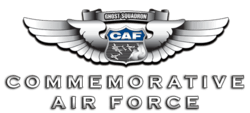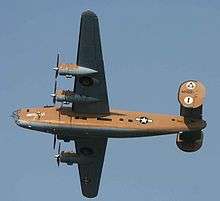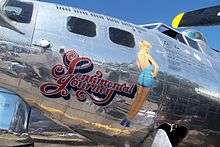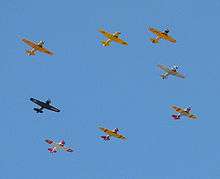Commemorative Air Force
The Commemorative Air Force (CAF), until 2002 the Confederate Air Force,[1] is a Texas-based non-profit organization dedicated to preserving and showing historical aircraft at airshows primarily throughout the U.S. and Canada.
 | |
| Abbreviation | CAF |
|---|---|
| Formation | 1961 |
| Location |
|
| Coordinates | 32.677229°N 96.860801°W |
| Website | commemorativeairforce |
Formerly called | Confederate Air Force |
History
The origin of the Commemorative Air Force can be found in an organization called the "Confederate Air Corps" created by Oscar Harper in Montgomery, Alabama in 1953.[2] Led by the fictional character "Thaddeus P. Throckmorton" and his recruiting officer "Jethro Culpepper", the CAC established several features that later became key characteristics of the CAF: folksy, tongue-in-cheek southern humor; a membership structure based on each member having the equal rank of colonel; and a rallying cry of "Semper, Mint Julep".

In 1957, Lloyd Nolen and four friends purchased a P-51 Mustang, each sharing in the $1,500 cost of the aircraft.[3][4] With the purchase of the Mustang, known as "Red Nose", the group that became the CAF was unofficially founded.[4] In 1958, the group made their second purchase of two Grumman F8F Bearcats[4] for $805 each. Along with the P-51, this gave the pilots the two most advanced piston-engine fighters to see service with the U.S. Army Air Forces and the United States Navy.
In 1960, the CAF began seriously to search for other World War II aircraft. The CAF colonels were shocked to find that the aircraft which played such a major role in winning World War II were being rapidly and systematically scrapped as obsolete with no efforts, not even by the Air Force or Navy, to preserve any for display for future generations. The warbirds that remained airworthy were mostly in private hands modified for air racing or had been converted for commercial use as air freighters and aerial firefighters.
On September 6, 1961, the CAF was chartered as a nonprofit Texas corporation to restore and preserve World War II-era combat aircraft.[5] By the end of the year, there were nine aircraft in the CAF fleet. By 1963, the group had achieved their goal of acquiring one of each American World War II fighter plane.[4] Their first airshow was held on March 10, 1963.[6]
In 1965, the first museum building was completed at old Rebel Field, Mercedes, Texas. The CAF created a new Rebel Field at Harlingen, Texas when they moved there in 1968,[4] occupying three large buildings including 26,000 square feet (2,400 m2) of museum space. The CAF fleet continued to grow. By the end of the decade, the CAF fleet included medium and heavy bombers such as the North American B-25 Mitchell, B-17, Consolidated B-24 Liberator. In 1971, they added one of the two airworthy Boeing B-29 Superfortress, FiFi.
In 1976, the CAF sponsored an air show where a B-29 bomber piloted by Paul Tibbets, the pilot who flew the B-29 which bombed Hiroshima during World War II, reenacted the atomic bombing of Hiroshima (including a mock mushroom cloud). This air show prompted the Japanese government to lodge a formal complaint with the United States Embassy, resulting in the American government issuing an apology.[7]
In 1983, the American Airpower Heritage Foundation was founded to financially support the CAF.[4]
The group's accomplishments were recognized in 1989 when it became a National Aviation Hall of Fame Spirit of Flight Award winner.[8] It was also honored that year when Texas Governor William Clements signed a resolution naming the CAF the air force of Texas.[4]
In 1990, the CAF added two more corporations.[4] The first was the American Airpower Heritage Flying Museum, tasked with obtaining and maintaining the CAF's aircraft titles. The second was the American Airpower Heritage Museum, which acquired and maintained the CAF's non-aircraft pieces and static displays.[4]
1991 saw the CAF moving operations to Midland, Texas.[5] Once in Midland, the group opened the American Airpower Heritage Museum facilities and the American Combat Airman Hall of Fame.
In April 2014, the CAF announced the move of their headquarters and all of the planes associated with the headquarters to Dallas Executive Airport in Dallas, Texas.[5][9][10] The museum and its artifacts (including the nose art collection) will also be moved to the new headquarters in Dallas.[11]
Membership
Today, the Commemorative Air Force comprises over 12,000 members,[12] including more than seventy regional groups, called wings or detachments, in twenty-seven states and four other countries. Several hundred members actively serve as pilots and flight and/or maintenance crew members committed to preserving American combat aviation heritage. The CAF is an all-volunteer organization, made up of members from all backgrounds. Membership is open to everyone age 18 or older, and cadet membership is available for those over 12 years of age. Although a 501(c)(3) nonprofit, tax-exempt group,[12][13] the CAF has received financial incentives from state and local governments related to its Dallas relocation as well as its time in Midland.[14][15][16][17]
Organization
The American Airpower Heritage Group is the parent organization and is made up of four separate corporations:[18]
- The Commemorative Air Force, which is the membership association
- A foundation, which controls the financial assets and endowment
- A museum, which manages the non-flying artifacts
- A flying museum, which operates the flying aircraft
Name
The original name, Confederate Air Force, started as a simple tongue-in-cheek joke, poking fun at the organization's ragtag beginnings. As the collection of warbirds at Central Valley Airport in Mercedes, Texas, started to grow, someone painted the name on the side of the original North American P-51 Mustang Red Nose. The name stuck, and it grew to the point where the airport was renamed Rebel Field, all members were called "colonels" (a tradition which still remains), and it led to the creation of a fictitious leader named Colonel Jethro E. Culpepper. There was even a humorous CAF twist put to the old AVG Flying Tigers World War II "blood chit" that read, "This foreign person has come to China to help in the war effort. Soldiers and civilians, one and all, should rescue, protect, and provide him medical care." The CAF version seen on the backs of flight suits and flight jackets stated, "This is a CAF aviator. If found lost or unconscious, please hide him from Yankees, revive with mint julep and assist him in returning to friendly territory. CONFEDERATE AIR FORCE."

In November 2000, the group voted to rename, using the initials "CAF" until a permanent name was selected.[1] Following a 2001 membership vote, the group changed its name to "Commemorative Air Force," effective January 1, 2002.[4] Many felt the name Confederate Air Force was confusing, did not accurately reflect the purpose of the organization, and was detrimental to fundraising efforts.[19] According to CAF chief of staff Ray Kinney, "In many people's minds, the word 'confederacy' brings up the image of slavery and discrimination. We, in no way, are associated with that kind of stuff. So, it gives us, in a way, a black eye."[20]
Objectives
The main objectives of the CAF are:[21]
- To acquire, restore, and preserve in flying condition a complete collection of combat aircraft which were flown by all military services of the United States and selected aircraft of other nations for the education and enjoyment of present and future generations of Americans.
- To provide museum buildings for the permanent protection and display of these aircraft as a tribute to the thousands of men and women who built, serviced, and flew them.
- To perpetuate in the memory and in the hearts of all Americans the spirit in which these great planes were flown in the defense of our nation.
- To establish an organization having the dedication, enthusiasm, and esprit de corps necessary to operate/maintain/preserve these aircraft as symbols of our American military aviation heritage.
Aircraft
.jpg)

As of 2015, the CAF owns 166 aircraft, of which 131 are in airworthy condition, 18 are undergoing maintenance, 15 are in restoration, and two are in storage.[12][23] The entire collection of CAF aircraft is known as the CAF Ghost Squadron.[24] Its aircraft range from the small Stinson L-5 Sentinel and Ryan PT-22 to the giant Boeing B-29 Superfortress; the Boeing B-17 Flying Fortress; and the Consolidated Liberator B Mk I/B-24A Liberator AM927. Many of the CAF aircraft are rare - the CAF operates one of only two flying examples of the historic Boeing B-29 Superfortress, and the only remaining flightworthy Curtiss SB2C Helldiver. Others, such as the B-24/LB-30 Liberator; the Bell P-63 Kingcobra fighter; the Japanese Mitsubishi A6M Zero; and the Douglas SBD Dauntless are one of only two or three of that type left flying today. The CAF also operates Axis and foreign aircraft such as the MiG 17 Fresco C.
.jpg)

- Aeronca L-3E Defender LIL' Show Me
- Aeronca L-16A - Arizona Wing
- Aichi D3A Val dive bomber replica (North American SNJ conversion)
- Beechcraft 18/C-45/SNB/JRB
- Beech AT-11 Kansan
- Beechcraft D-18S A-235 - Arizona Wing
- Beechcraft UC-45J 51242 - Central Texas Wing
- Beech T-34A Mentor (A-45)
- Bell P-39Q Airacobra 42-19597 - Central Texas Wing
- Bell P-63
- Bell P-63A-6-BE Kingcobra 42-68941 - Dixie Wing
- Bell P-63F Kingcobra 43-11719
- Boeing-Stearman PT-17 Kaydet (USN N2S)
- Stearman N2S-4 c/n 75-4894 - Arizona Wing
- Stearman N2S c/n 75-8291 - Utah Wing[26]
- Boeing B-17 Flying Fortress
- Boeing B-17G Flying Fortress Sentimental Journey 44-83514 - Arizona Wing
- Boeing B-17G Flying Fortress Texas Raiders 44-83872 - Gulf Coast Wing
- Boeing B-29 Superfortress ''Fifi' 44-62070
- CASA 352L (Spanish-built Junkers Ju 52) German bomber/transport
- Cessna UC-94/C-165 (Airmaster)
- Cessna UC-78 Bobcat (RCAF Crane) 1632 - Wright Stuff Squadron
- Cessna UC-78B Bobcat 43-32578 - Jayhawk Wing
- Consolidated B-24A/LB-30/Liberator I/C-87 40-2366 Ol 927 (ex-RAF AM927)
- Consolidated PBY-6A Catalina BuNo 64092 - Lake Superior Squadron
- Consolidated PBY-6A Catalina BuNo 64097 - Lake Superior Squadron
- Curtiss C-46F-1-CU Commando China Doll 44-78663 - Southern California Wing
- Curtiss P-40 Warhawk (Kittyhawk and Tomahawk)
- Curtiss P-40N Warhawk c/n 29629 (ex-RCAF 867)
- Curtiss SB2C-5 Helldiver BuNo 83589 - Cactus Squadron/West Texas Wing
- De Havilland DH-94 Moth Minor c/n N94DH - Rio Grande Valley Wing
- de Havilland Canada DHC-1 Chipmunk
- Douglas A-26/B-26 Invader
- Douglas A-26B-35DL Invader Spirit of Waco 41-39427 - CAF Invader Squadron
- Douglas A-26B-50DL Invader 44-34313 - Air Group One
- Douglas A-26C-40DT Invader Miss Murphy 44-35601 - Arizona Wing
- Douglas A-26C-40DT Invader Daisy Mae 44-35643 - Sierra Hotel A-26 Group
- Douglas B-23 Dragon
- Douglas DC-3/C-47/C-53/R4D
- Douglas C-47B Skytrain The Black Sparrow 44-77013 (USN R4D-7) - Great Lakes Wing
- Douglas C-47 Skytrain That's All, Brother 42-92847 – Texas Wing
- Douglas C-53D-DO/DC-3A Skytrooper D-Day Doll 42-68830 - Inland Empire Wing
- Douglas R4D-6/C-47J Skytrain Ready 4 Duty BuNo 50783 - Dallas/Fort Worth Wing
- Douglas SBD-5 Dauntless BuNo 54532[27]
- ERCO Ercoupe
- Fairchild PT-19, PT-23 and PT-26
- Fairchild PT-19A - Southern California Wing
- Fairchild PT-23A-HO 42-49250 - Southern California Wing
- Fairchild Cornell 42-65935 - Highland Lakes Squadron
- Fairchild UC-61 Argus/Forwarder
- Fairchild F-12R46 Argus - Southern California Wing
- Fairchild F-12R Argus - High Sky Wing (painted as J2K)
- Fleet 16B Finch c/n 383 - Rio Grande Valley Wing
- Focke-Wulf Fw 44J Stieglitz RF+GJ - Rio Grande Valley Wing
- Goodyear FG-1D Corsair 530 BuNo 92468 - CAF Corsair Sponsor Group, Dixie Wing
- Grumman AF-2S Guardian BuNo 126731 - Arizona Wing
- Grumman Avenger
- Grumman/General Motors TBM-3E Avenger BuNo 53353 - Missouri Wing
- Grumman/General Motors TBM-3E Avenger BuNo 85597 - Florida Wing
- Grumman/General Motors TBM-3S Avenger BuNo 53503 - Rocky Mountain Wing
- Grumman/General Motors TBM-3S Avenger BuNo 91426 - National Capital Squadron
- Grumman/General Motors FM-2 Wildcat BuNo 86819 - Arizona Wing
- Grumman F6F-5 Hellcat Minsi III - Southern California Wing
- Grumman F8F-2 Bearcat BuNo 122674 - Southern California Wing
- Grumman S-2B Tracker BuNo 136404 - Old Dominion Squadron (status unknown, crashed 2007)
- Hawker Sea Fury FB.10 c/n 41H-696792 (ex Royal Navy WJ288) - Memphis Squadron
- Interstate L-6 Grasshopper
- Lockheed C-60 Lodestar
- Lockheed Model 18-50 Lodestar c/n 18-2274 - Hampton Roads, Virginia, painted as 255884
- Lockheed C-60 Lodestar Goodtime Gal 42-56005 c/n 18-2478 - Houston Wing
- Lockheed PV-2 Harpoon
- Lockheed T-33 Shooting Star
- McDonnell Douglas F-4N Phantom II BuNo 153016 - Arizona Wing
- Messerschmitt Bf 108 Taifun German liaison/trainer
- Mikoyan-Gurevich MiG-15UTI 012 - Arizona Wing
- Mikoyan-Gurevich MiG-15bis 4415 - Arizona Wing
- Mikoyan-Gurevich MiG-17 - Arizona Wing
- Mikoyan-Gurevich MiG-21PF Fishbed-D 507 - Arizona Wing
- Mitsubishi A6M3 Model 22 Zero Japanese carrier fighter - Southern California Wing
- Mitsubishi Zero fighter replica (North American Harvard conversion)
- Morane-Saulnier MS-502 painted as Fieseler Fi 156 Storch - s/n 361 Delaware Valley Wing
- Nakajima B5N Kate torpedo bomber replica (Vultee BT-13 Valiant conversion)
- Naval Aircraft Factory N3N-3 - West Houston Squadron
- Naval Aircraft Factory N3N-3 N4009A - High Sierra Squadron
- North American AT-6 Texan (USN SNJ, RAF Harvard, various models)
- North American Harvard II c/n 81-4099 - Inland Empire Wing
- North American SNJ-4 Texan c/n 88-13041 - Buffalo Heritage Squadron
- North American SNJ-4 Texan c/n 88-13517 - Highland Lakes Squadron
- North American SNJ-4 Texan c/n 88-10177 - Southern California Wing
- North American SNJ-5 Texan c/n 88-16676/42-84895/BuNo 84865 - Southern California Wing
- North American SNJ-5 Texan BuNo 90725 - Arizona Wing
- North American SNJ-6 Texan BuNo 112180 - Minnesota Wing
- North American B-25 Mitchell
- North American B-25J-5NC Yellow Rose 43-27868 - Central Texas Wing
- North American B-25J-10NC Maid in the Shade 43-35972 - Airbase Arizona
- North American B-25J-20NC Miss Mitchell 44-29869 - Minnesota Wing
- North American PBJ-1J-30NC Semper Fi 44-30988 - Southern California Wing
- North American B-25J-30NC Show Me 44-31385 - Missouri Wing
- North American B-25J-32NC Devil Dog 44-86758 - Devil Dog Squadron
- North American NA-64 Yale (painted as BT-14)
- North American P-51 Mustang
- North American P-51D-25-NA Mustang Man-O-War 44-72739 - Southern California Wing
- North American T-28 Trojan
- Piper L-4F
- Republic P-47N-5RE Thunderbolt 44-88548 - Lobo Squadron, fuselage only
- Ryan PT-22 Recruit
- Ryan PT-22 Recruit 41-1902 - Minnesota Wing
- Ryan L-17 Navion
- Ryan Navion A N444AC - Highland Lakes Squadron[28]
- Sikorsky UH-19D-2-Sl Chickasaw 54-1416 helicopter
- Schweizer TG-3A training glider - Arizona Wing
- Stinson AT-19 Reliant (Royal Navy) - Carolinas Wing
- Stinson 108 (World War II Civil Air Patrol)
- Stinson L-5 Sentinel (USN/Marines OY)
- Stinson L-5E-1VW/OY-2 Sentinel Carin' Belle 44-18143/BuNo 04013 - Ohio Valley Wing
- Stinson L-5 Sentinel c/n 76-0272 - Dallas/Fort Worth Wing
- Stinson L-5 Sentinel Frozen Assets 42-98667 - Minnesota Wing
- Stinson L-9B Reliant
- Supermarine Spitfire FR Mk.XIVe NH749 - Southern California Wing
- Taylorcraft L-2
- Vultee BT-13/BT-15/SNV
- Vultee BT-13A 41-11538 - Minnesota Wing
- Vultee BT-13A Valiant
- Vultee BT-13A 41-21178 - Gulf Coast Wing
- Yakovlev Yak-3UA - Southern California Wing
AIRSHO

AIRSHO is a yearly event at Midland International Airport showcasing the CAF's aircraft.[6] Because its aircraft tend to be spread out over large geographic distances, and most Ghost Squadron aircraft rarely fly more than a few hours from their home base, AIRSHO is also an opportunity for CAF members to meet up. Ghost Squadron aircraft usually attend AIRSHO every other year. The CAF AIRSHO is the largest warbird air show in the world, with more than eighty warbirds flying per show.
Wings and squadrons
The CAF has many wings and squadrons. Starting in 2013, a limited number of larger units may be designated as an "airbase." The first is Airbase Arizona, located at Falcon Field in Mesa, AZ and redesignated in Jun 2013. Most CAF units are in the United States, but there are four outside the country.
US wings and squadrons
- Alaska
- Anchorage — Col Hunt Alaska Wing[29]
- Arkansas
- Little Rock — Razorback Wing[29]
- Arizona
- Mesa — Airbase Arizona at Falcon Field[29]
- California
- Camarillo — Southern California Wing[29]
- Modesto — Central California Valley Squadron[29]
- Oakland — Golden Gate Wing[29]
- Riverside — Inland Empire Wing[29]
- Sacramento — Sacramento Delta Squadron[29]
- San Diego — Group One Wing[29]
- Upland — Third Pursuit Squadron[29]
- Upland — FM-2 Wildcat Sponsor Group[29]
- Colorado
- Broomfield — Mile High Wing[29]
- Grand Junction — Rocky Mountain Wing[29]
- Florida
- Georgia
- Peachtree City — Dixie Wing[29]
- Idaho
- Caldwell — Idaho Wing[29]
- Indiana
- Indianapolis — Indiana Wing[29]
- Iowa
- Council Bluffs — Great Plains Wing[29]
- Kansas
- Louisiana
- New Orelans — Big Easy Wing[29]
- Minnesota
- Mississippi
- Madison — Mississippi Wing[29]
- Missouri
- St. Charles — Missouri Wing[29]
- Montana
- Bozeman — Big Sky Wing[29]
- Nevada
- New Jersey
- Forked River — Delaware Valley Wing[29]
- New Mexico
- Albuquerque — Lobo Wing[29]
- Hobbs — New Mexico Wing
- New York
- Akron — Buffalo Heritage Squadron[29]
- North Carolina
- Southern Pines — Carolinas Wing
- Ohio
- Cleveland — Cleveland Wing (now Buffalo Heritage Squadron)
- Columbus — Ohio Valley Wing
- Oklahoma
- Pennsylvania
- Pittsburgh — Keystone Wing
- Rhode Island — Sea Control Squadron RI[29]
- South Dakota
- Sioux Falls — Joe Foss Squadron[29]
- Tennessee
- Memphis — Delta Blues Squadron/Memphis Squadron[29]
- Texas
- Abilene — Big Country Squadron
- Addison — B-29/B-24 Squadron
- Amarillo — Dew Line Squadron
- Aransas Pass - Maxine Flourney 3rd Coast Squadron[29]
- Brownsville — Rio Grande Valley Wing[29]
- Burnet — Highland Lakes Squadron[29]
- Conroe — Big Thicket Wing
- Corpus Christi — Third Coast Squadron
- Corsicana — Coyote Squadron[29]
- Dallas — P-40 Sponsor Group[29]
- Dallas — Redbird Squadron[29]
- Dallas — P-34 Sponsor Group[29]
- Dallas — Training Detachment One[29]
- Dallas — WASP Squadron[29]
- Fredericksburg — Tex Hill Wing
- Fort Worth — Fort Worth Wing[29]
- Fort Worth — Invader Squadron[29]
- Gainesville — Ground Forces Detachment[29]
- Georgetown — Devil Dog Squadron[29]
- Graham — Cactus Squadron[29]
- Houston — Houston Wing (formally West Houston Squadron)[29]
- Lancaster — Dallas/Fort Worth Wing[29]
- Marshall — Lone Star Wing[29]
- Midland — AIRSHO Support Detachment
- Midland — Blastards Detachment[29]
- Midland — High Sky Wing[29]
- Midland — West Texas Wing[29]
- Odessa — Desert Squadron[29]
- Pealand — Tora Sponsor Group[29]
- San Antonio — Tex Hill Wing[29]
- San Marcos — Centex Wing[29]
- Spring — Gulf Coast Wing[29]
- Utah
- Virginia
- Washington
- Everett — Rainier Squadron[29]
- Wisconsin
- National units
References
Notes
- "Confederate Air Force may rename". Associated Press. November 18, 2000. Retrieved March 17, 2020.
- Chicago Tribune, February 1, 1956, page 6
- "CAF History." Commemorative Air Force. Retrieved: April 3, 2011.
- Leatherwood, Art. "COMMEMORATIVE AIR FORCE". Texas State Historical Association. Retrieved June 30, 2015.
- Associated Press (April 29, 2014). "Commemorative Air Force Moving Headquarters to Dallas". NBC. Retrieved June 30, 2015.
- "AIRSHO". Commemorative Air Force. Retrieved June 30, 2015.
- "U.S. Apologizes to Japan for Show That Re‐enacted Hiroshima Attack". The New York Times. October 15, 1976. p. 10. Retrieved March 14, 2019.
- "Milton Caniff Spirit of Flight Award". National Aviation Hall of Fame. Archived from the original on July 1, 2015. Retrieved June 30, 2015.
- Collins, Mike (April 29, 2014). "CAF headquarters moving to Dallas Executive". Aircraft Owners and Pilots Association. Retrieved June 30, 2015.
- Gillett, Bud (April 29, 2014). "The Commemorative Air Force Relocates To Oak Cliff". CBS. Retrieved June 30, 2015.
- Rist, Matthew (December 11, 2014). "CAF Announces Plans to Move Equipment, Museum Artifacts to Dallas". CBS. Archived from the original on December 28, 2014. Retrieved June 30, 2015.
- "New Director of Operations for the CAF". Warbirds News. June 22, 2015. Retrieved June 30, 2015.
- "CAF_IRS_501c3_letter.pdf" (PDF). Retrieved June 30, 2015.
- https://www.sao.texas.gov/SAOReports/ReportNumber?id=15-013
- Vanderlaan, Jon (February 17, 2015). "Commemorative Air Force Loses State Money". Odessa American. Retrieved October 24, 2016.
- Appleton, Roy (November 3, 2014). "Dallas council panel backs incentives for Commemorative Air Force". The Dallas Morning News. Retrieved October 24, 2016.
- Appleton, Roy (November 12, 2014). "Dallas City Council approves relocation grant to Commemorative Air Force". The Dallas Morning News. Retrieved October 24, 2016.
- "Dallas Executive Airport: Past, Present and Future" (PDF). City of Dallas. Economic Development Committee. November 3, 2014.
- "CAF News 2001 Press Release." Archived September 27, 2007, at the Wayback Machine Commemorative Air Force. Retrieved: August 14, 2007.
- http://amarillo.com/stories/2001/12/08/tex_confederate.shtml
- "Commemorative Air Force History & Mission". Commemorative Air Force. Retrieved June 30, 2015.
- "CAF "Diamond Lil" back to B-24A configuration." Archived September 29, 2007, at the Wayback Machine Commemorative Air Force. Retrieved: August 14, 2007.
- "State of the CAF 2016 Report". The Dispatch. December 2016.
- "CAF Facts and Information." Archived July 3, 2007, at the Wayback Machine Commemorative Air Force. Retrieved: July 22, 2007.
- Boeing B-17G "Flying Fortress" Archived May 12, 2009, at the Wayback Machine.
- http://www.cafutahwing.org/stearman-n2s.html
- Wood, Keith, Flying the Ghost - SBD Dauntless, December 2009, pp.11-14
- North American L-17 Navion Archived April 7, 2014, at the Wayback Machine Accessdate:4 April 2014
- "CAF Unit Map". Commemorative Air Force. Retrieved May 27, 2019.
Bibliography
- Ogden, Bob. Aviation Museums & Collections of North America. London: Air-Britain, 2007. ISBN 0-85130-385-4.
External links
| Wikimedia Commons has media related to Commemorative Air Force. |
- Commemorative Air Force official site
- Aerial Visuals Search Commemorative Air Force
- AirNav, FlightAware - Old Reb Airport information